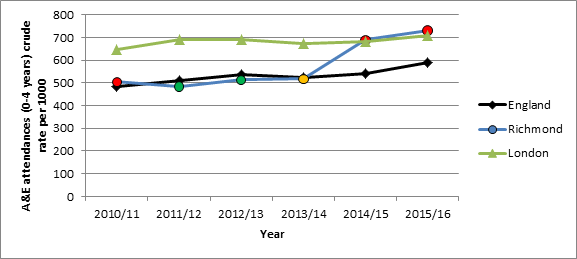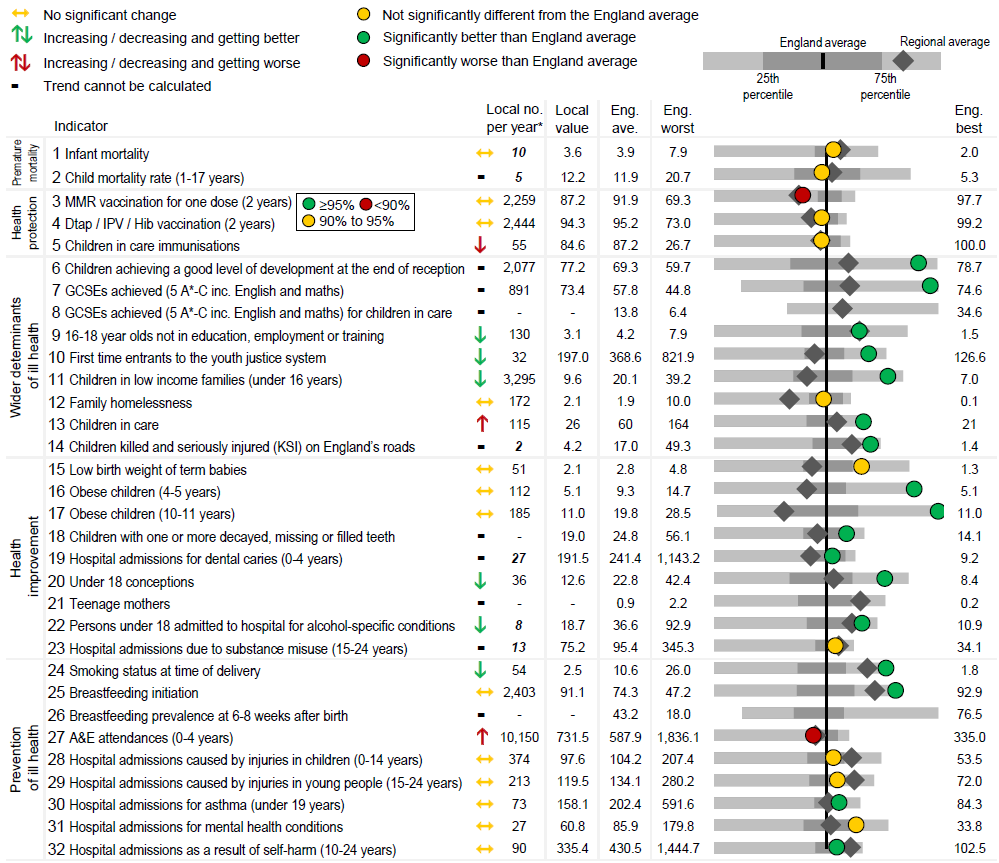Public Health England has recently published a Child Health Profile 2017 for each local authority in England.
The report is updated annually and provides a snapshot of Richmond borough performance against 32 selected indicators compared with the rest of England. Key 2017 findings are highlighted below.
The full Child Health Profile 2017 report for Richmond borough can be accessed here.
What does this mean for Richmond?
- Children and young people under the age of 20 years make up 25% of the Richmond population (47,800 in number). This is a similar proportion to England as a whole (24%).
- The health and wellbeing of children living in Richmond borough is significantly better than the average for England according to many of the indicators.
Health protection
- Immunisation coverage for childhood vaccines remains below the 95% level required to protect children and young people from serious infectious disease. Compared with the England average (92%), a significantly lower percentage of children (87%) have received their first dose of MMR immunisation by the age of two in the Richmond borough.
- The percentage of children in care with up-to-date immunisations has decreased from 100% for the past 4 years to 85% in 2016. However, it is not significantly different from the England average (87%) or the London average (84%).
Wider determinants of ill health
- A higher than average proportion of children in Richmond are achieving a good level of development at the end of the early years’ foundation stage of education (77%), which is significantly higher than the England average (69%).
- The percentage of 16-18 year olds not in education, employment or training, has decreased to 3.1% in 2015 and is now significantly better than the England average (4.2%), and similar to the London average (3.4%).
- The rate of children in care under 18 years in Richmond has increased from 22 per 10,000 in 2015 to 26 per 10,000 children looked after in 2016, but remains lower than the England average and the London average. In absolute numbers, this is a change from 95 to 115 children in care.
Health improvement
- Levels of overweight and obesity among primary school aged children are significantly lower than nationally, but the numbers are still high. In 2015/16, 112 children in reception and 185 of Year 6 pupils were obese.
- The under 18 hospital admissions for alcohol-specific condition has reduced since 2010/11-12/13 (39 per 100,000) to 2012/13-14/15 (19 per 100,000). This is significantly better than the England average (37 per 100,000) but similar to the London average (24 per 100,000).
Prevention of ill health
- The rate of A&E attendances (0-4years) has increased steadily the last three years, from 518 per 1000 in 2013/14 to 732 per 1000 in 2015/16. This is now significantly higher than both the England average (588 per 1000) and the London average (707 per 1000).

- Richmond has the third highest hospital admissions caused by injuries in children (0-14). This is significantly worse than London average but similar to the England average.
- Richmond has the fifth highest rate of hospital admissions caused by injuries in young people (15-24) in London. There were 213 per 10,000 admissions in Richmond, which is significantly worse than London (98 per 10,000) but not significantly different from England (134 per 10,000).
- There were 90 hospital admissions as a result of self-harm (10-24 years) in 2015/16, which is significantly lower than the average for England but still significantly worse than the London average. Furthermore, Richmond has the 3rd highest rate in London.

The chart below shows how children’s health and wellbeing in Richmond compares with the rest of England. The local result for each indicator is shown as a circle, against the range of results for England which are shown as a grey bar. The black line indicates the England average. The key to the colour of the circles as well as the arrows showing trend is shown below. Note: Where data is not available or figures have been supressed, this is indicated by a dash in the appropriate box.
